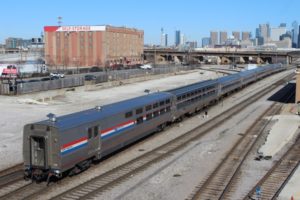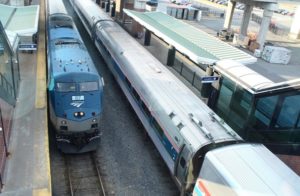
The metrics for restoring service [see “Amtrak releases criteria for restoring long-distance service,” Trains News Wire, Aug. 11, 2020] include comparing the spring and summer bookings for each train in February 2021 with the same metric a year earlier, though adjusted for reduced capacity. Management says daily operation will resume only when this measure of advance demand is attained.
Overall trends
Amtrak ridership has been inching up through August, according to a series of daily booking monitors sent to state agencies. The latest report shows the seven-day average has beaten the one-day peak attained on July 2.
Systemwide revenue has risen to only 25% of last year’s totals for a comparable period, but long-distance trains together have been holding steady at about 50%. That includes sleeping-car revenue at about 70% of the previous year. State-supported short-distance trains and Northeast Regional categories have climbed to the 25% level as some frequencies have been restored, while Acela reservations, with only three weekday Boston-Washington round-trips, have yet to crack 10% of last year’s pace.
This reflects business travel patterns studied extensively by Dublin University Professor Aisling Reynolds-Feigham, who participated in a Transportation Research Forum webinar last week.
“There’s been a universal concern that the business travel premium enjoyed by the airlines may be significantly curtailed because of changes in work practices that the pandemic has brought,” she said.
Given the continued worldwide aversion to air travel, Reynolds-Feigham was surprised to see relatively undiminished November and December air capacity in North America, Europe, and Asia. She expects to see downward revisions, but the airlines appear to be hedging bets that they will achieve government assistance and that leisure travel will strengthen. Unlike Amtrak, they are keeping existing travel options available at this point. Among U.S. major air carriers, she notes that this summer, Southwest Airlines reduced capacity the least of the major carriers.
Sleeping car upside
Looking more closely at Amtrak specifics, the Cardinal’s sleeper bookings are up the largest percentage of any long-distance train. The addition of a Viewliner II baggage-dormitory car increased revenue-carrying capacity in the train’s lone sleeping car, allowing previously ultra-high pricing to be more demand-responsive.

On the other hand, revenue from sleepers and coaches on the Silver Star and Silver Meteor have lagged behind other long-distance trains because Amtrak cut seven trains from the weekly schedule on July 6. After previously reserved October trips are rebooked or cancelled as a result of cutbacks, there is no reason to believe the rest of the fleet won’t suffer the same fate.
Significantly, the company recently incorporated mention of private rooms along with safe-travel cleanliness efforts on Amtrak trains in weather and traffic advertising on five to eight radio stations in major Northeast Corridor markets plus Chicago. The list will be expanded to the West Coast in September. Also, short local TV spots with the same message have been placed in the Northeast, Chicago, Atlanta, San Diego, San Francisco, Oklahoma City, Portland, Ore., and Charleston, S.C.
Close to departure
That advertising, along with social media posts and email outreach to former passengers, also mentions that travelers can now see how heavily booked a train is before they buy a ticket [see “Digest: Amtrak now offering capacity information on website,” Trains News Wire, August 12, 2020]. The data also provides a window to how Amtrak seats get sold on days leading up to the time a train leaves the station.
Running with fewer coaches and trains limited to 50% capacity, departures on some routes tend to fill up quickly. Some illustrative examples:
–Chicago-Memphis, City of New Orleans: The sold-out Aug. 30 trip had been at just 20% on Aug. 22.
–Portland-Seattle, Coast Starlight: Sold out on Aug. 30, it was 40% on Aug. 22.
–Chicago-Little Rock, Texas Eagle: At 90% (one seat available) Aug. 28, it had been at 30% on Aug 21.
–New York-Syracuse, Lake Shore Limited: Sold out Aug. 30, it was at 60% on Aug. 23.
–Chicago-Cleveland, Capitol Limited: At 80% on Aug. 30, it was 60% on Aug 23.
These trains, like most in the long-distance network, have always been important conduits of intermediate traffic whether or not they operate in tandem with state-sponsored service. A survey across the system indicates most start their journeys at 70% to 79% of capacity. Many are lightly patronized on some portions of the route. South of St. Louis on the Eagle, for example, patronage on Aug. 30 drops to 50% overnight in the coach that connects with the Sunset Limited at San Antonio.
With states unsure whether they can afford to bring more service back, trains like the Starlight, which adds frequencies to one long Pacific Northwest corridor and two in California, are providing valuable daily departures for passengers who decide to travel by rail days — not months — in advance.













